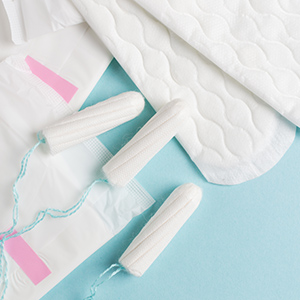
By Darcy Sullivan and Joane Nagel
Implications for Public Health
Women and girls may face health risks and emotional hardship when emergency shelters don't provide the necessary products and facilities to address menstrual hygiene. Including menstrual hygiene management in mass care plans can help protect this population’s health and alleviate stress surrounding menstruation.
Periods don’t stop during disasters. Although menstruation is a topic many people find awkward, emergency responders and those who manage evacuations and shelters can’t avoid the subject. Not planning for menstrual hygiene needs can make a disaster even more stressful for women and girls who are menstruating.
Every day an estimated 14 million American women and girls are managing their periods. When hazards such as floods, fires, or hurricanes destroy homes and businesses, women often lose access to menstrual products. During evacuation or relocation, these products might not be available, resulting in extended use of soiled products or bloodstained clothing. These unmet menstrual hygiene management (MHM) needs can become a source of self-consciousness and embarrassment for menstruating women and girls.
Impacts of Unmet Menstrual Health Management Needs
When women lack access to proper menstrual hygiene products such as menstrual pads or tampons, they might be forced to reuse these items or use them for longer periods than recommended by health experts. This can lead to physical health issues such as urinary tract infections or toxic shock syndrome. Perhaps more common are impacts on girls’ and women’s dignity and mental health when they are unable to attend to their menstrual needs. Although lack of planning for menstrual hygiene needs has been a documented problem in emergency situations, the issue persists.
Menstruation was among the many challenges facing women and girls in New Orleans during and immediately after Hurricane Katrina in 2005. In one instance, a 50-year-old woman with obvious, heavy menstrual bleeding on her dress and legs was evacuated from a rooftop in New Orleans by a male rescuer. This embarrassing condition was compounded for the woman when, during her several-day stay in a shelter, she had no access to MHM products or clean underwear.

For young girls who have less experience with menstruating, such a situation can be especially distressing. One mother displaced by Hurricane Katrina reported that her daughter had her first menstrual period while they were living in a shelter at the Cajundome. She said, “I was just so sorry it had to happen there…She was confused about it, no privacy. She would say, ‘Mom, hurry, hurry.’ I just sat her down and talked and hugged her.”
Emergency Responders Also Menstruate
Menstrual hygiene during disasters is not only a gender issue for those impacted by disasters, but also for the professionals who respond to them. Female emergency responders face MHM challenges in the field where they might not have the time and privacy to take care of their needs. They might also be confronted by dismissive or negative attitudes within the organizations in which they serve.
Women in firefighting and the armed forces report that they must sometimes manage their menstrual cycles in difficult situations that range from a lack of access to menstrual products to stereotypes about women’s emotions and premenstrual syndrome (PMS) to outright sexual harassment. For instance, former U.S. Forest Service (USFS) wildfire crew member Alisha Dabney said she left the USFS after a series of discriminatory incidents including being ordered by a supervisor to report when her menstrual cycle started. Such challenges have led some women emergency responders to take drugs to suppress menstruation.
Recommendations for Period Support During Disasters
Addressing menstrual hygiene management needs during disasters is an unrecognized challenge. Twelve years later, in the mass displacements from Hurricane Harvey in Texas, researchers at the Columbia University Mailman School of Public Health found that MHM was largely missing from the agendas of responding agencies. They noted that even the American Red Cross “does not highlight provision of feminine hygiene products in its list of health services and basic supplies.”
Since, come fire or high water, women will continue to menstruate, it would be wise for emergency planners to address the MHM needs of women and girls in emergencies. The good news is there are several simple, easily instituted actions that could greatly improve their experience:
Make girls and women’s menstrual needs visible, straightforward, and matter-of-fact by including MHM in emergency plans and supplies.
Include menstrual products and period packs in emergency relief kits.
Stockpile menstrual products—which are often inexpensive when purchased directly from distributors in large quantities—in advance.
Ensure toileting facilities have bins with lids to properly dispose of pads and tampons, as well as running water to wash reusable hygiene products and underwear.
Equip toileting facilities with proper doors, locks, and lighting for women’s privacy and safety.
Include people who menstruate in emergency policymaking, planning, and response.
Although our society deems menstruation an uncomfortable subject, it is a fact of life and one that impacts women and girls in disasters from multiple viewpoints—those who respond, those who must evacuate, and those forced to stay temporarily in public shelters. With just a little pre-planning and awareness, we can work to address this important and sensitive public health issue.
Suggested Tools
A Toolkit for Integrating Menstrual Hygiene Management into Humanitarian Response
Columbia University and International Rescue Committee
The Menstrual Hygiene Management (MHM) in Emergencies toolkit provides streamlined guidance to support organizations and agencies seeking to rapidly integrate MHM into existing humanitarian response. This is designed to address the needs of women and girls living in emergency contexts who are directly affected by this issue.
For a list of all the tools included in this special collection, visit the Mass Sheltering Tool Index. A list of further readings are also available.
Darcy Sullivan is a doctoral student of sociology at the University of Kansas. Her research investigates reproductive health disparities experienced by women with disabilities. Her current projects examine pregnancy intentions and desires among women with disabilities and analyze how women manage menstruation during natural disasters. Sullivan holds a master’s degree in sociology from the University of Kansas and a bachelor's in sociology from Murray State University.